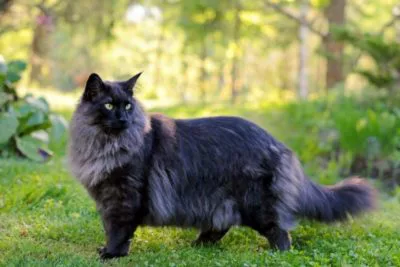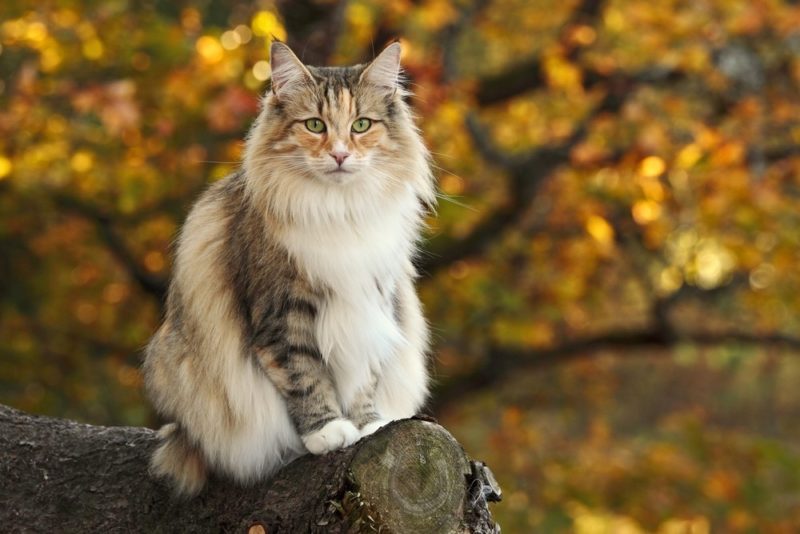History
The exact history of the Norwegian forest cat is a subject shrouded in mystery and legend. This history dates back through the annals of time to its better-known origins in Scandinavia. Here, they have evolved and adapted to the harsh weather conditions of the Norwegian Forests.
At a time when its human counterparts the Vikings were making their own mark on history. Subjecting many countries to their ferocious raiding parties.
It is highly probable that the Norsemen would have required a strong and resilient feline to accompany them on their travels. Thus keeping their famous longboats and ships free of vermin and protecting their valuable grain stores on land and sea.
The Norwegian Forest Cat would have been the ideal choice, its superb hunting skills were well known, so it seems likely that this was the beginning of the Skogkatt’s domestication from forest to farmland.
They are not afraid of water and in their natural habitat would have supplemented their diet with fish hooked out of stream and rivers by their strong claws.
Skogkatt is the term for Norwegian Forest Cat.
They are also fondly known as ‘Wegies’. A nickname first adopted by the Americans. Over time, interbreeding of the Norwegian Forest Cat with other feral short-haired domestic cats caused great concern amongst Norwegian cat fanciers, fearing that its status as a pedigree breed would be lost.
In 1930 an attempt to start a breeding program was initiated but had to be abandoned during World War II. It was then continued in the 1950’s when King Olaf of Norway proclaimed the Skogkatt the official Norwegian Cat.
In 1975 Norsk Skogkatting was the first official Norwegian Forest Cat Breed Club to be established, in order to preserve and promote the breed. In 1977 The Feline International Federation of Europe accepted the Norwegian Forest Cat for Championship Competition.
Price of Norwegian Cats
Prices of the Norwegian cats can range from a few hundred to several thousand dollars.
| Description | Price |
|---|---|
| Norwegian Forest Cat Kitten (Breeder) | $600 – $1,200 |
| Norwegian Forest Cat (Adoption) | $50 – $200 |
| Initial Setup and Supplies | $450 – $1,200 |
| Monthly Care Costs | $55 – $500 per month |
| Boarding or Pet Sitting | $50 – $80 per day |
| Pet Insurance | Approx. $40 per month |
The prices of Norwegian Cats can vary relying on various factors, including the cat’s pedigree, age, place, and breeder.
Characteristics
To enable the Norwegian Forest Cat to survive the cold and unforgiving Norwegian winters. Nature has provided it with the most stupendous double coat. The top coat called the guard hairs is long, flowing and water repellent. These also cover the length of a long plumed tail which is held erect.
The undercoat is soft and dense.
In winter the mature Skogkatt sports a spectacular ruff or mane, which recedes somewhat with the onset of warmer weather, but will return with the change of seasons. The Norwegian Forest Cat can be found in almost every color combination except chocolate. The whites are known as Snow cats.
In the cat’s natural habitat this wonderful coat does not matt, the loose hairs being removed as the cat passes through the undergrowth. But during its moult, regular grooming of the domestic Norwegian Forest Cat is essential to prevent matting and tangling.
Appearance
The head is triangular in shape with a strong chin and a straight profile. Its ears are long and tufted with guard hairs protecting them from ice and snow. The eyes are large, bold and bright, sparkling like jewels of emerald green, gold, and copper. These are almost almond shaped with the outward corners pointing upwards at a slight angle.
White cats have either both eyes blue, gold or green, or one blue eye and the other gold or green thus being called ‘odd-eyed’. The Norwegian Forest Cat is an excellent climber, its hind legs being longer than its forelegs, and can leap to extraordinary heights, especially when something interesting needs investigating.
The paws are large and tufted with very strong claws.
The Norwegian Forest Cat although strong and sturdy in a build is also of very elegant appearance. It has an affectionate, lively and curious nature and loves human companionship.
High-Whites (My personal favorite)!
Why not a stunningly beautiful high-white?
These predominantly white Wegies’ epitomize the breed of Snow Cats from a snow-covered Norwegian land.
Why do some discriminate against this particularly gorgeous colorway of the Norwegian Forest Cat?
It is high-time the high-white was recognized as the doyen of this magnificent breed of cats. All are beautiful, but to me, the high-white is irresistible.
My cats just love to curl up beside me at the end of a busy day, demanding affection, and occasionally, insist on thoroughly grooming me as well as each other!

